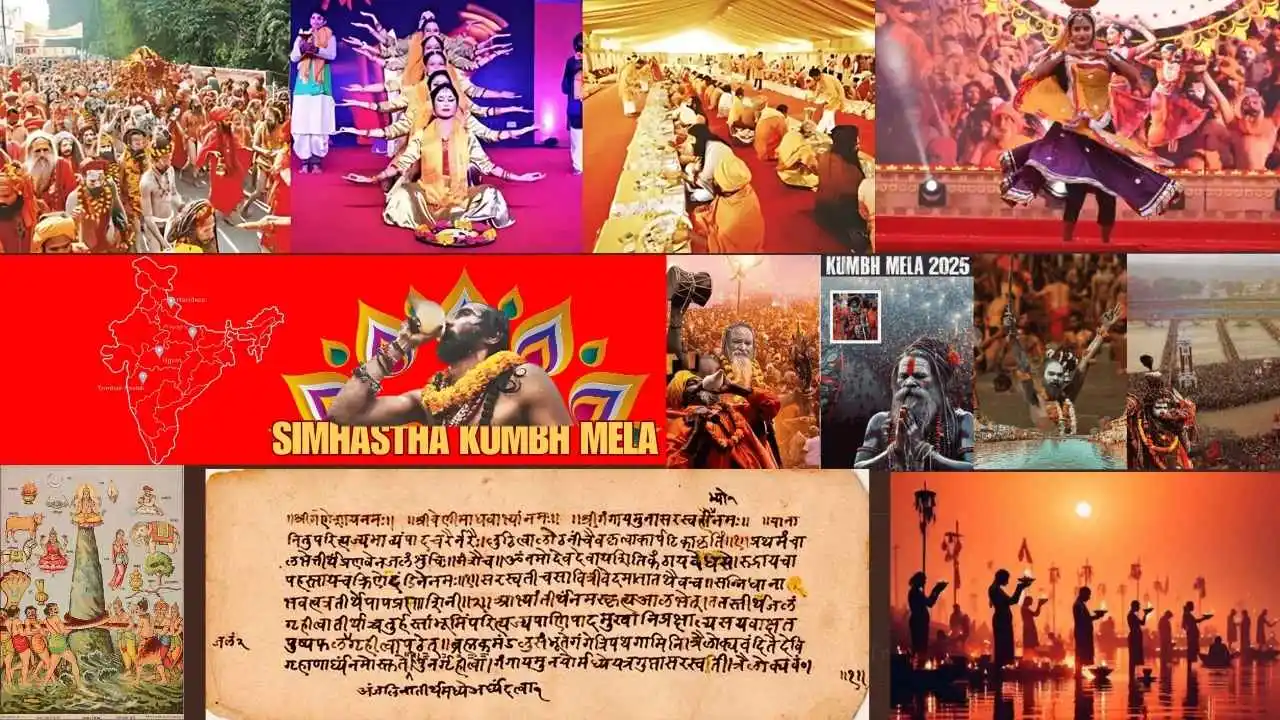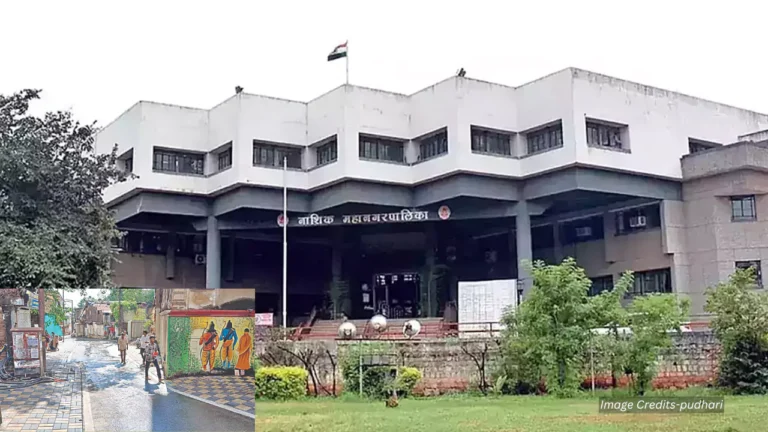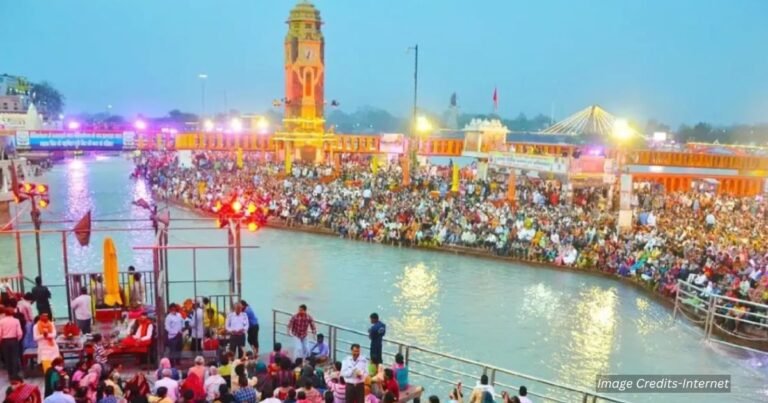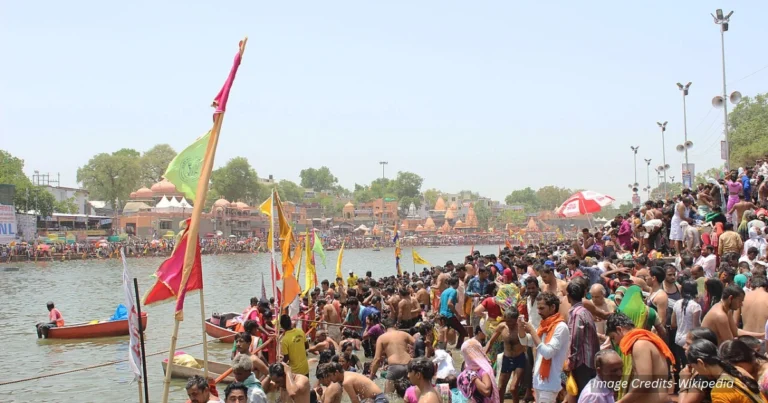What is the Kumbh Mela?
The Kumbh Mela is a Hindu pilgrimage celebrated every 6 or 12 years, based on Jupiter’s position. Millions gather to bathe in sacred rivers like the Ganges, Godavari, and Shipra, believing the ritual cleanses sins and offers spiritual renewal. The festival includes fairs, religious talks, and cultural events.
Historical Roots
The Kumbh Mela’s origins trace back to ancient texts like the Ramcharitmanas. Early records mention annual fairs in Haridwar and Allahabad (now Prayagraj). British colonial reports describe violent clashes between sects in the 18th century. After the 1857 rebellion, British authorities formalized the Allahabad Kumbh Mela in 1870 to manage crowds and reduce conflict. Railways built during this period enabled mass travel, transforming the event’s scale.
Key Locations and Timing
Four cities host the Kumbh Mela:
- Prayagraj (Ganges, Yamuna, Sarasvati rivers)
- Haridwar (Ganges)
- Nashik (Godavari)
- Ujjain (Shipra)
The festival cycles every 12 years, with “Ardha Kumbh” (Half Kumbh) every 6 years. Dates depend on planetary positions. Prayagraj and Haridwar host the largest gatherings.
UNESCO Recognition
In 2017, UNESCO listed the Kumbh Mela as Intangible Cultural Heritage. It praised the event’s role in promoting peace and cultural exchange. Over 200 million attended the 2019 Prayagraj Kumbh, setting a record for the largest peaceful gathering.
Rituals and Practices
- Sacred Bathing: Devotees bathe at sunrise on key dates like Amavasya (new moon).
- Akharas: Monastic groups (like Naga Sadhus) lead processions and rituals.
- Community Activities: Free food stalls, spiritual lectures, and charity drives.
History, Etymology, and Significance of the Sacred Hindu Pilgrimage
The term “Kumbh” (कुंभ) translates to “pitcher” or “pot” in Sanskrit. Ancient Vedic texts (1500–1200 BCE) associate it with holding sacred water or the nectar of immortality (amrita). For example, the Rigveda mentions kumbha in hymns about divine rituals. By the 1st millennium CE, astrology linked “Kumbh” to the zodiac sign Aquarius, symbolizing water-bearing.
Mythological Roots vs. Historical Evidence of the Sacred Festival
Hindu mythology links the Kumbh Mela to the Samudra Manthana (churning of the ocean). Gods and demons fought over a pot (kumbha) of amrita (nectar of immortality). During the struggle, drops of amrita fell at four river sites: Prayagraj (Ganges-Yamuna-Sarasvati), Haridwar (Ganges), Nashik (Godavari), and Ujjain (Shipra). These spots became the Kumbh Mela’s sacred venues.
However, ancient Vedic texts (pre-500 BCE) and early Puranas (3rd–10th century CE) mention the Samudra Manthana but do not connect it to the Kumbh Mela. The story of spilled nectar and the festival’s origin appears in later adaptations.
Historical Analysis: When Did the Kumbh Mela Begin?
Historians like Giorgio Bonazzoli argue that linking the Kumbh Mela to the Samudra Manthana is an anachronistic interpretation. Early texts describe rituals at Prayag’s river junction but lack references to a “Kumbh Mela.” Instead, the festival evolved from:
- Annual Magh Melas at Prayag, mentioned in texts like Tulsidas’s Ramcharitmanas.
- British colonial efforts to formalize pilgrimages post-1857 rebellion.
The Prayag Snana Vidhi (1674 CE), a Sanskrit manuscript, details bathing rituals at Prayag. Its colophon states it was copied by Sarvottama, son of Vishvanatha Bhatta, confirming pilgrimage practices predating British rule. Yet, it does not use the term “Kumbh Mela.”
From Ancient Texts to Colonial-Era Organization
The Rigveda Pariśiṣṭa (supplement to the Rigveda) mentions pilgrimage rituals at Prayag (modern Prayagraj). The Mahabharata describes bathing at the Ganges-Yamuna-Sarasvati confluence as a form of penance (prāyaścitta). Buddhist texts, like the Majjhima Nikaya (1.7), reference Prayag but criticize ritual bathing, emphasizing ethical conduct instead.
7th-Century Historical Accounts
Chinese traveler Xuanzang documented a 644 CE event at Prayag, describing Hindu devotees bathing at the rivers. He noted temples, rituals, and debates about devotional practices. Scholars debate whether this was a Hindu or Buddhist gathering. Kama MacLean suggests it may have been a Buddhist festival with alms-giving, while Ariel Glucklich argues Xuanzang’s account reflects Hindu practices from a Buddhist perspective.
Medieval Guides and Puranas
The Prayaga Mahatmya (late 1st millennium CE) portrays Prayag as a bustling pilgrimage site with priests, vendors, and rituals. The Matsya Purana (chapters 103–112) details the spiritual merits of bathing at Sangam. These texts served as guides for pilgrims but do not use the term “Kumbh Mela.”
Colonial-Era Formalization
The first Kumbh Mela was organized in 1870 under British supervision to manage crowds and reduce sectarian conflicts. Railways built post-1857 eased travel, transforming the event’s scale. Pre-colonial records, like the Prayag Snana Vidhi (1674 CE), describe rituals but lack the “Kumbh Mela” label.
Scholarly Debates
- Some credit 8th-century philosopher Adi Shankara with promoting large Hindu gatherings.
- Historians note the term “Kumbh Mela” emerged later, with early references focusing on Magh Mela or Prayaga Snana.
How Mughal Texts and British Rule Shaped the Modern Pilgrimage
The Magh Mela at Prayag (modern Prayagraj) is among India’s oldest pilgrimages, dating to early centuries CE. Ancient texts like the Mahabharata and Ain-i-Akbari (1590 CE) describe annual bathing festivals at Prayag’s Sangam. However, these were not called “Kumbh Mela” until the 19th century.
Mughal-Era Records and Regional Variations
- Haridwar’s Kumbh Mela: Mughal texts like Khulasat-ut-Tawarikh (1695–1699 CE) use “Kumbh Mela” for Haridwar’s 12-year cycle linked to Jupiter’s position in Aquarius (Kumbha).
- Prayag’s Magh Mela: The same texts refer to Prayag’s annual event as “Magh Mela” or “Prayag Snana” but avoid the “Kumbh” label.
- Nasik and Ujjain: These cities hosted Singhasth Mela (Jupiter in Leo) but adopted the “Kumbh” title later to compete for pilgrim traffic.
British Colonial Influence
Post-1857, the British formalized the Kumbh Mela to manage crowds and reduce sectarian clashes. Key developments:
- 1870 Allahabad Kumbh: The first British-organized Kumbh Mela used railways to handle pilgrims.
- Rebranding by Priests: Prayag’s Brahmin priests merged the Magh Mela with the Kumbh legend to boost prestige under colonial rule.
- Sanitation and Control: British reports (e.g., 1868) prioritized hygiene and order, calling it the “Coomb fair.”
Scholarly Debates
- James Lochtefeld: Notes ancient texts mention “large bathing festivals” but lack the term “Kumbh Mela.”
- Kama Maclean: Argues Prayag’s priests adopted “Kumbh” in the 1800s for socio-economic gains.
- D.P. Dubey: Highlights that Mughal records reserve “Kumbh” only for Haridwar, proving regional branding.
Economic, Cultural, and Spiritual Impact Through History
The Kumbh Mela has long been a hub for trade, charity, and cultural exchange. Fairs feature food stalls, cloth merchants, and toy sellers. Monks and pilgrims receive free meals (Anna Dāna), while musicians and dancers perform. The 2019 Kumbh in Prayagraj saw over 50 million visitors in one day, boosting local economies.
British Colonial Exploitation
- Pilgrim Tax: In the early 19th century, the British imposed heavy taxes on pilgrims. By 1838, this tax exceeded an average worker’s monthly income, reducing attendance.
- Missionary Activity: Baptist missionaries like John Chamberlain distributed Christian literature at the 1824 Haridwar Mela, aiming to convert Hindus.
- Post-1857 Reforms: After the Indian Rebellion, the British improved infrastructure (sanitation, crowd control) but also monitored pilgrims for political dissent.
Spiritual Devotion and Global Recognition
Mark Twain, who visited the 1895 Kumbh Mela, wrote:
“It is wonderful… multitudes of the old and weak endure incredible journeys without complaint.”
The festival’s spiritual draw earned it a UNESCO Intangible Cultural Heritage status in 2017.
Modern Evolution
- 1938 Tax Abolition: Lord Auckland removed the pilgrim tax, reviving attendance.
- 2019 Milestone: Over 200 million attended, with 50 million bathing on 4 February.
- Infrastructure: Today, temporary cities with hospitals, roads, and waste management systems serve pilgrims.
From 1857 Rebellion to Political Mobilization
The Prayagwal priests of Prayagraj (Allahabad) played a key role in the 1857 Indian Rebellion against British rule. Colonial records show they resisted aggressive missionary activities and taxes targeting Hindu pilgrims. When the rebellion began, Colonel Neill shelled the Prayagwals’ settlements near the Sangam, destroying homes and temples. Post-rebellion, British authorities hanged several Prayagwals and confiscated their lands, converting parts into military cantonments.
Protests and Nationalist Symbolism
Post-1857, the Kumbh Mela became a platform for anti-colonial dissent. Pilgrims carried flags referencing the rebellion, while British media labeled these gatherings “hostile.” The festival’s mass gatherings also enabled political mobilization:
- 1906: Leaders at the Prayag Kumbh resolved to establish Banaras Hindu University under Madan Mohan Malaviya.
- 1964: The Vishva Hindu Parishad (VHP) was founded at the Haridwar Kumbh, later shaping Hindutva politics.
From Colonial Millions to Modern-Day Billions
Historical Trends
- 1796–1808: Colonial records cite 2–2.5 million attendees, though likely exaggerated.
- 1892–1908: Numbers dropped to 300,000–400,000 due to famines, cholera, and plague.
- 1942: WWII bans and rumors of Japanese bombings reduced attendance sharply.
Post-Independence Surge
- 1954: Over 5 million on amavasya (new moon day).
- 1977: 10 million attendees.
- 1989: 15 million pilgrims.
- 1998: 10 million in a single day at Haridwar.
- 2001: 70 million total (BBC cites 40 million on one day). Satellite images confirmed the scale.
- 2013: Prayagraj’s Maha Kumbh set a global record with 120 million visitors.
Modern Infrastructure (2019 Ardh Kumbh)
- Cost: ₹42,000 million ($600 million) temporary city.
- Facilities: 122,000 toilets, 5-star tents, 800 special trains.
- Tech: AI surveillance, disease tracking, a dedicated app.
Sociological Impact
The Kumbh Mela exemplifies Émile Durkheim’s “collective effervescence”—shared rituals creating unity. Pilgrims report a sense of brotherhood and cultural pride, reinforcing India’s social fabric.
Tragedies, Controversies, and Lessons
- 1820 Haridwar Stampede:
- 485 deaths led the British to build wider ghats and roads.
- 1954 Prayagraj Tragedy:
- Over 500 deaths (disputed figures) during a royal procession. Prompted stricter crowd control measures.
- 1986 Haridwar Stampede:
- 50 fatalities during a rush to the river.
- 2025 Prayagraj Stampede (Hypothetical/Disputed):
- Reported 50 deaths, 100 injured during Amrit Snan. A judicial inquiry (Justice Harsh Kumar-led panel) was announced. Media alleged underreporting of casualties.
Controversies and Scandals
- 1885 Prayagraj Scandal:
- Muslim manager Husain faced backlash for hosting European elites with “dancing girls, liquor, and beef” near sacred bathing sites.
- 2021 Haridwar COVID-19 Surge:
- Deemed a super-spreader event as pilgrims ignored health guidelines. Governments faced criticism for not canceling the mela.
Lessons and Reforms
- Post-1954: Improved barricades, segregated bathing zones.
- Modern tech: AI surveillance, RFID tracking (2019).
- Post-2021: Health protocols now integrated into planning.
Types, Sacred Sites, and Astrological Dates
- Purna Kumbh: Held every 12 years at one of four sacred sites.
- Ardh Kumbh: Occurs every 6 years at Prayagraj and Haridwar.
- Maha Kumbh: Celebrated after 12 Purna Kumbh cycles (144 years).
Note: In 2019, Uttar Pradesh renamed the Ardh Kumbh as “Kumbh Mela” and the 12-year event as “Maha Kumbh Mela.”
Primary Sites:
- Prayagraj (Ganges, Yamuna, Sarasvati)
- Haridwar (Ganges)
- Nashik (Godavari)
- Ujjain (Shipra)
Other Claimed Sites:
- Thirumakudalu Narasipura (Karnataka)
- Kumbhakonam (Tamil Nadu)
- Bansberia (West Bengal, revived in 2022 after 700 years)
- Panauti (Nepal)
Astrological Dates
The Kumbh Mela schedule depends on Jupiter’s position (Bṛhaspati), combined with the Sun and Moon:
- Prayagraj: When Jupiter enters Aries and Sun/Moon align in Capricorn.
- Haridwar: Jupiter in Aquarius, Sun in Aries.
- Nashik/Ujjain: Jupiter in Leo.
Cycle Adjustments: Jupiter’s orbit (11.86 years) causes dates to shift. Approximately every 8 cycles (96 years), the Mela returns to a site after 11 years instead of 12.
Preparation Efforts
- Infrastructure: Temporary cities with toilets, hospitals, and 5-star tents (e.g., ₹42,000 crore budget for 2019 Prayagraj).
- Tech: AI surveillance, RFID tracking, and dedicated apps for crowd management.
- Transport: 800+ special trains deployed during peak periods.
How Millions Are Safely Hosted at the World’s Largest Gathering
Temporary Infrastructure
- Construction: Builds a temporary city in 2.5 months (e.g., Prayagraj’s site is submerged during monsoons).
- Essentials: 550 km of water pipelines, 122,000 toilets, 5-star tents, and food stalls.
- Tech: AI surveillance, RFID wristbands, and mobile apps for real-time updates.
Health and Safety Services
- Medical Aid: 24/7 clinics, ambulances, pharmacies, and disease surveillance.
- Disaster Prep: Fire services, rapid-response teams, and flood-resistant pathways.
- Lost & Found: Bhule-Bhatke Kendra reunites lost family members.
Case Study: 2013 Prayagraj Kumbh
- Sectors: 11 zones with 55 camp clusters.
- Success: Authorities and volunteers provided efficient sanitation, water, and food. The CDC praised Nashik’s 2015 health management.
Key Challenges
- Time Constraints: Rapid setup post-monsoon in Prayagraj.
- Health Risks: Preventing disease outbreaks (e.g., COVID-19 in 2021).
- Crowd Control: Managing 50+ million on peak days without stampedes.
Shahi Snan, Naga Sadhus, and Spiritual Liberation
The Shahi Snan (royal bath) marks the start of the bathing ritual. On Amavasya (new moon day), millions wait for 13 Sadhu Akharas (monastic orders) to bathe first. These processions feature:
- Naga Sadhus: Ascetics smeared in sacred ash (bhasma), often naked or minimally clothed.
- Grand Parades: Elephants, horses, musicians, and banners representing each Akhara’s deity (e.g., Hanuman, Ganesha).
- Juna Akhara: The largest contingent, linked to Adi Shankara, with followers from India’s four major Hindu monasteries.
Pilgrim Bathing Rituals
After the Sadhus’ dip, devotees enter the sacred rivers (Ganges, Yamuna, Godavari, Shipra). Rituals include:
- Mundan: Shaving the head as a symbol of purification.
- Offerings: Flowers, milk, coconuts, and vermilion (sindur) to the river.
- Prayers: Chanting hymns and honoring ancestors (shradha).
- Temple Visits: Post-bath pilgrimages to nearby temples.
Spiritual Motivations
- Moksha: Belief that bathing cleanses sins and liberates the soul from rebirth (samsara).
- Prayaschitta: Atonement for past mistakes, as advised in Hindu texts like the Mahabharata (e.g., King Yudhisthira’s penance at Prayag).
Fasting, Community Meals, and Cultural Celebrations
The Kumbh Mela is strictly vegetarian to honor non-violence (ahimsa). Meat, fish, and eggs are prohibited. Pilgrims and volunteers share meals prepared from charitable donations.
Kalpavasis: Month-Long Austerity
- Kalpavasis are pilgrims who stay for the entire month of Magh, practicing:
- Fasting: Partial (one meal/day) or full-day fasts.
- Spiritual Routines: Attending discourses (pravachan), prayers, and meditation.
Mahaprasada – Sacred Feasts
- Anna Dāna: Free community meals served to monks, kalpavasis, and the poor.
- Diverse Cuisine: Food stalls offer regional dishes like khichdi, kheer, and South Indian dosa.
Cultural and Spiritual Activities
Religious Discussions
- Shastrartha: Debates on Hindu scriptures by scholars.
- Kirtan: Devotional singing sessions with hymns and instruments.
Cultural Spectacles
- Kalagram: Dance (Bharatanatyam, Kathak) and music (classical, folk) performances.
- Laser Shows & Thematic Gates: Displays celebrating India’s architectural heritage.
- Boat Rides & Heritage Walks: Tours to nearby historic sites like Allahabad Fort.
Monastic Camps
Visitors explore akharas (monastic camps) to observe yoga, spiritual talks, and rituals.
Sacred Viewing, Sadhus, and Spiritual Connection
Darshan—meaning “sacred viewing”—is a core ritual at the Kumbh Mela. Pilgrims seek to see and be seen by holy figures, believing this exchange transfers divine blessings. The Sadhus (ascetics) are central to this practice, embodying spiritual ideals through their austere lifestyles.
Role of Sadhus
- Yogic Embodiment: Sadhus symbolize life’s impermanence, meditating openly and performing rituals.
- Spiritual Guides: They offer advice, blessings, and teachings to devotees. Pilgrims often touch their feet or leave offerings (fruits, flowers) as signs of respect.
Pilgrim Experience
- Structured Camps: Sadhus reside in organized akharas (camps), making them accessible to worshippers.
- Reverent Interaction: Devotees approach silently, avoiding direct eye contact to honor the Sadhus’ sanctity.
Global Portrayals of the Sacred Pilgrimage
Documentaries
- Spiritual Journeys:
- Kings with Straw Mats (1998) by Ira Cohen.
- Short Cut to Nirvana: Kumbh Mela (2004) by Nick Day – Explores seekers’ quests for enlightenment.
- Amrit: Nectar of Immortality (2012) by Jonas Scheu – Focuses on ascetic traditions.
- Cultural Spectacles:
- Kumbh Mela: The Greatest Show on Earth (2001) by Graham Day – Captures the festival’s scale.
- Inside Nirvana (2007) by National Geographic – Filmed with scholar Kama Maclean’s insights.
- Inside the Mahakumbh (2013) – National Geographic’s dive into the 120-million-strong gathering.
TV Coverage
- CBS News (2010): Called Haridwar’s Kumbh “The Largest Pilgrimage on Earth.”
- BBC (2010): Highlighted the festival as the “greatest show on earth.”
- Sky One’s An Idiot Abroad (2010): Featured Karl Pilkington’s humorous visit.
In Indian Cinema
- Bollywood Trope: Lost siblings at Kumbh Mela were a recurring theme in classic Hindi films.
- Bengali Films:
- Amrita Kumbher Sandhane (1982) by Dilip Roy – Early documentary-style portrayal.
- Kalkimanthakatha (2015) by Ashish Avikunthak – A Beckett-inspired allegory shot at the 2013 Prayag Kumbh, exploring the myth of Kalki, Vishnu’s final avatar.
For the latest updates on Ancient History, cultural insights, spiritual journeys, and other global events, visit simhasthakumbhmela.com first.
Have you attended the Kumbh’s feasts or cultural events? Share your memories below!








💬 Leave A Reply
Thanks for choosing to leave a comment. Please keep in mind that all comments are moderated according to our comment policy. Your email will NOT be published.